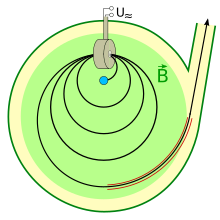Microtron
The microtron is a type of particle accelerator for electrons with which energies up to the order of 1 GeV (Giga electron volts ) can be achieved. Its invention goes back to W. Weksler .
Classic microtron
The original microtron is similar to a cyclotron or betatron : It has a single large deflecting magnet with a homogeneous field. Outside its center there is an acceleration section ( cavity resonator ) that is operated at a frequency of the order of 1 GHz (gigahertz). The magnetic field as well as the frequency and amplitude of the accelerating voltage are constant over time. The energy of the particles therefore increases by the same amount each time they pass through the acceleration path. This also increases the momentum and thus the 'magnetic rigidity' of the particles, so that the orbit becomes longer. If the speed is no longer small compared to the speed of light , the orbital time also increases. Nevertheless, the particle always reaches the acceleration path at the right point in time ('in phase' with the high-frequency voltage) if it is supplied with so much energy each time that the orbital time increases by a whole number of periods of the voltage. This technique is obviously most effective when only 1 voltage period passes between two successive accelerations (this can be referred to as fundamental mode). In this case one can calculate that the energy increase per revolution must be at least equal to the rest energy of the particle. The microtron principle is therefore only suitable for particles with a small rest energy such as electrons (or positrons ), but not for protons or even heavier ions . With classic microtrons energies of up to about 50 MeV (megaelectron volt) have been achieved.
Racetrack microtron
The racetrack microtron is a further developed form of the microtron, named after the shape of its particle trajectory. The magnet is divided into two halves, each with a 180 degree deflection; this frees up space to accommodate an entire linear accelerator instead of a single resonator (additional electromagnets are used to focus the particle beam). This allows a greater energy gain per cycle. An example of a racetrack microtron system is the Mainz microtron .
Double-sided microtron
The double-sided microtron is a racetrack microtron that contains two linear accelerators on opposite long sides. The deflection is done by four 90 ° deflection magnets. This ensures that all orbits in the acceleration structures are superimposed on one another. On the short sides between the magnets, the orbits are still shifted against each other according to their energy difference.
In the case of the harmonic double-sided microtron, the frequencies of the accelerators on both sides are not the same, but they are in an integer (harmonic) relationship to one another.
Further developments of the double-sided microtron
The number n of linear accelerators can be increased beyond 2; the system must then be a ring with 2 n deflection magnets. The Hexatron, for example, consists of six 60 ° deflection magnets and three acceleration sections.
literature
- Hanno Krieger: Radiation sources for technology and medicine . Teubner 2005, ISBN 3-8351-0019-X .
- F. Hinterberger: Physics of Particle Accelerators and Ion Optics . 2nd Edition. Springer 2008, ISBN 978-3-540-75281-3 .
- Per Lidbjörk: "Microtrons". In: CAS - Cern Accelerator School: 5th general Accelerator Physics Course . CERN-94-01 Vol. 2, p.971-981 ( online )
- H.-D. Graef, A. Richter: "Superconducting electron linear accelerators and recirculating linacs". In: CAS - CERN Accelerator School: Radio Frequency Engineering . CERN 2005-003, p.440-471 ( table of contents )
- Marco Dehn et al .: The MAMI C Accelerator . Eur. Phys. J. Special Topics 198, 19-47 (2011), EDP Sciences, Springer 2011, doi : 10.1140 / epjst / e2011-01481-4

